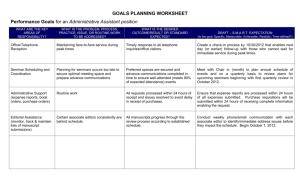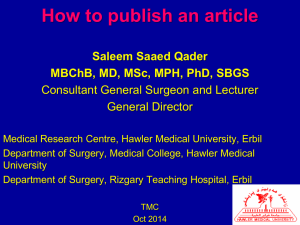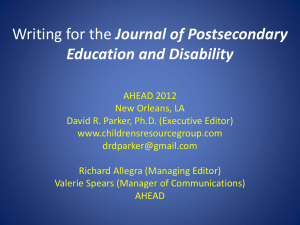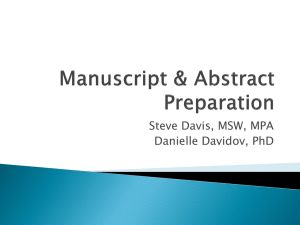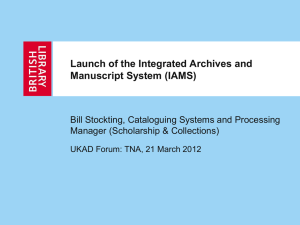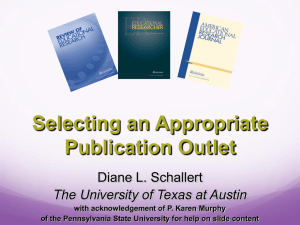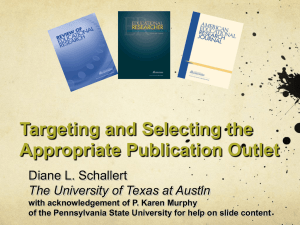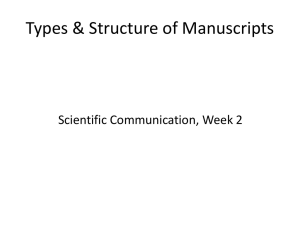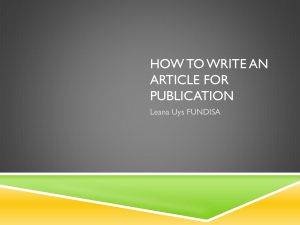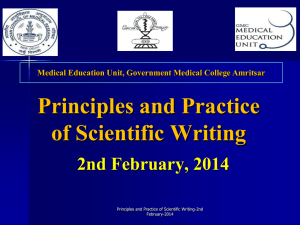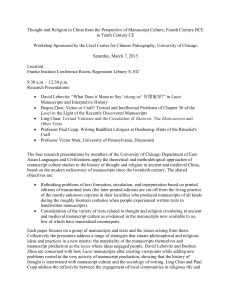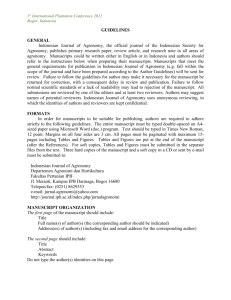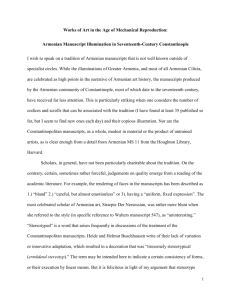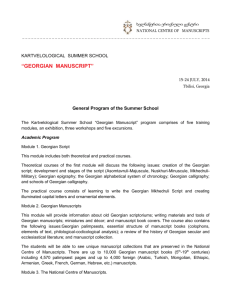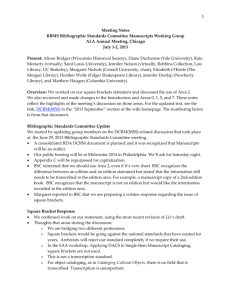So, You Want to Get Published - Journal of Adolescent Health
advertisement
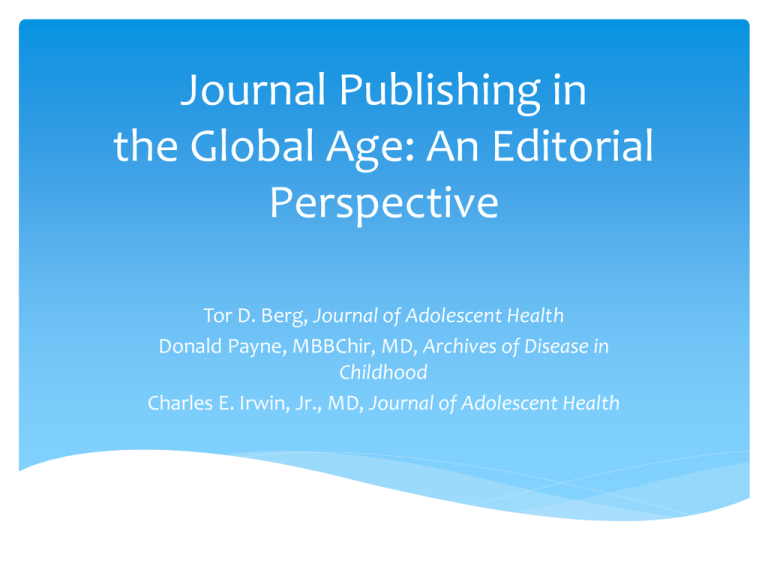
Journal Publishing in the Global Age: An Editorial Perspective Tor D. Berg, Journal of Adolescent Health Donald Payne, MBBChir, MD, Archives of Disease in Childhood Charles E. Irwin, Jr., MD, Journal of Adolescent Health Why publish? Disseminate findings Replication Inform clinical care Inform interventions Inform policy Improve research methodology Career considerations A Publication Strategy Choosing the type or form of the article Observing the formal requirements of scientific publication Writing or composing the article Choosing a journal Submitting your manuscript Revising your manuscript Accepting rejection Arranging publication Choosing the Type of Article to Submit Review articles Full length empirical articles Brief reports Case studies or observational reports Editorials, commentaries, and letters The Formal Requirements of Scientific Publishing International Committee of Medical Journal Editors (ICMJE): Uniform Requirements for Manuscripts http://ww.icmje.org The Abstract: A Tool for Success Solving problems Clarify your thoughts Distill those thoughts and ideas Identify the most important Connecting with editors Getting reviewed Getting found Getting read Getting cited Structured vs. Unstructured Abstracts Structured Unstructured The Structure of a Scientific Article Section I: Introduction — Progress from the general to the specific Present the general subject or problem Review the literature Statement of hypothesis: Your argument in the context of other work What is the aim of the study? What is the point of all this?? The Structure of a Scientific Article Section II: Methods Design Sample Context and setting Materials and Instruments Validity and reliability Protocols and IRB The Structure of a Scientific Article Section III: Presenting the data — From the specific to the general Results: Describe the findings Discussion: Place the research in the context of other work Limitations: Do not be afraid Conclusion: Application of the results; implications for future research; “Main Message” for clinicians/researchers/administrators/policymakers Works cited/References Authorship Issues Origin of the idea Development of the outline Design and writing of the approved protocol Data acquisition Scientific leadership in conducting the study Analysis and interpretation Writing the manuscript Responsibility for the final paper Ability to defend the content Minimum Basis for Authorship Requires active participation in all of the following: Conception/design of work, data collection, and/or data analysis and interpretation, AND… Drafting manuscript or reviewing/revising critical sections (i.e., that portion of manuscript for which coauthor claims expert defense responsibility), AND…. Responsibility for final version of the manuscript More Authorship Issues No person shall be listed as author merely by virtue of his/her position in the responsible organization or dissertation committee! Multiple authors: suggested that brief statements of exact contribution of each author be prepared for interdisciplinary studies (to clarify potential concerns) Authorship: Early Considerations Create a written agreement: Number of manuscripts expected to evolve from project Subjects to be covered Identity of all person assigned to co-author reports Conflict of Interest Definition should be clear Potential, Perceived, or Real conflict Disclose on the title page of the manuscript Explicitly state the role of the study sponsor If no role, then say that Avoid entering into agreements that interfere with complete and independent access to data Protection of Human Research Subjects All studies of human subjects must be evaluated by an appropriate institutional review board Even for secondary analyses, you should apply for and receive an exemption from your IRB Report IRB approval in the Methods section of your manuscript Registration of Clinical Trials Increasingly, journals are requiring registration of clinical trials Broad definition: drugs, surgical procedures, devices, behavioral treatments, process-of-care changes, etc. JAH does not, though it is highly recommended Several public registries available U.S. National Institutes of Health’s ClinicalTrials.gov Australia New Zealand’s ANZCTR.org.au Global ISRCTN Register ISRCTN.org Writing the Article Telling a good story Good research question Rigorous design, good response, clean data Clear and reliable analysis Abstract to Discussion But… Anticipate Writing Obstacles Such as: 1. Too busy 2. Teaching preparation takes up all time 3. “I will write as soon as I ________” 4. Making writing your #1 goal 5. Inability to reach writing site 6. Needing to read “one more book” 7. Inability to start 8. Fear of controversial topic and permanency of publication 9. Not in the mood 10. Childcare responsibilities 11. Inability to move forward 12. Dog ate my flash drive Four Keys to Academic Writing Success 1. 2. 3. 4. First and foremost, get writing! Make it social Persist despite rejection Pursue your passion Reading the Scholarly Literature There is so much to read! Make a plan to read what you can Skim the piece and focus on what you need to know Topic Approach Argument Ideas for New Habits Spend mornings reading/taking notes on journals that arrived (or were posted online) the previous day Read/skim 5 pieces for a set amount of time each day Mark paragraphs that contain important organizing ideas, then copy/paste to a new document Read articles from your target journal; familiarize yourself with the tone or melody or the journal Choosing a Journal Message and Contribution of the Article Try to focus on 2–3 messages or takeaways Theoretical contribution Focus on behavior and predictors of behavior Methodological contributions Clinical focus Public health or policy Audience for the Message Healthcare providers Researchers Methodologists Which journals have you cited? Regional, national, or international? Journal Adolescent Health Mission Statement The Journal of Adolescent Health is a multidisciplinary scientific Journal, which seeks to publish new research findings in the field of Adolescent Medicine and Health ranging from the basic biological and behavioral sciences to public health and policy. We seek original manuscripts, review articles, letters to the editor, commentaries and clinical observations from our colleagues in Anthropology, Dentistry and Oral Health, Education, Health Services Research, International Health, Law, Medicine, Mental Health, Nursing, Nutrition, Psychology, Public Health and Policy, Social Work, Sociology, Youth Development, and other disciplines that work with or are committed to improving the lives of adolescents and young adults. Archives of Diseases in Childhood Aims and Scope Archives of Disease in Childhood is an international peer review journal that aims to keep paediatricians and others up to date with advances in the diagnosis and treatment of childhood diseases as well as advocacy issues such as child protection. It focuses on all aspects of child health and disease from the perinatal period (in the Fetal and Neonatal edition) through to adolescence. ADC includes original research reports, commentaries, reviews of clinical and policy issues, and evidence reports. Areas covered include: community child health, public health, epidemiology, acute paediatrics, advocacy, and ethics. Career Considerations Where else have you published? What journal is best for your career? How quickly do you need to publish? Calculating Impact Factor Total number of citations, during 2011, to articles published in 2009 and 2010 3.334 factor 2011 impact Total number of “citable items” published in 2009 and 2010 Dissemination of Results Until recently, journals restricted published findings to paid subscribers and licensees Journal owns copyright and sells access to cover publication costs Digital distribution lowers costs for journals and enables far broader dissemination New models to distribute publication costs Open Access Open Access Full open access BioMedCentral, PLoS Author fee, institutional subsidies, advertising Sponsored articles JAH, and all Elsevier titles Delayed access Manuscript posting National funding bodies; NIH access policy and PubMedCentral Submitting Your Manuscript Submission process Cover letter Process of uploading manuscripts Suggesting reviewers Cover Letter Check instructions Often this is the first part the editor sees Make it clear how and why the study is important Explain why the manuscript is important for this journal List other publications cited in journal Identify your similar or related publications or submitted manuscripts Statement of Authorship Increasingly journal-specific forms Must be signed by all authors Electronically submitted Suggesting reviewers Why? Gesture of goodwill, and it moves the paper along Good evidence that author-suggested reviewers rate manuscripts more favorably Who? Not your mentor, co-author, colleague, etc. Not someone you have formally acknowledged Authors you have cited in references JAH Review Process 1,106 manuscripts reviewed internally 730 desk rejected (66% of all manuscripts) 16 invited to resubmit as a Brief (2.2% of desk rejected manuscripts) 376 peer reviewed (34% of all manuscripts) 206 rejected (54.8% of peer reviewed manuscripts 170 accepted (45.2 % of peer reviewed manuscripts) Revising Your Manuscript Submission To Revise or Not to Revise Virtually never accept first drafts Revision letter is an indication of interest Revision increases odds of eventual publication Must revise to resubmit elsewhere May see the same reviewer at another journal Review process is didactic; improves the paper Approaching the Revisions Distancing strategy But be prompt Respond with a clear and constructive revision and response letter Respond to all comments Be systematic; a table format is helpful Juxtapose divergent comments Revision process is a conversation amongst peers The Revision Letter Resubmit Checklist of documents necessary for revision Response letter Revised manuscript Revised tables and figures Re-review by editors and/or original reviewers Final acceptance at editors discretion Accepting Rejection Common reasons for rejection Poor English usage. Replicative, confirmatory, or localized findings Causation ascribed to associations Poorly contextualized results English usage English is a difficult language Scientific vocabulary and usage can idiosyncratic and archaic Attempt to enlist the help of a native English speaker Professional editors specializing in technical English Can be expensive Establish links to individuals and organizations that already publish in English UNICEF, UNFPA, WHO, etc. Novelty Replicative and confirmatory results, while important, are generally not published in top journals Findings from a specific local population might be most useful to a local audience Correlational data JAH publishes very few studies that are based only on correlational or cross-sectional data In most cases, longitudinal data is necessary to inform interventions and clinical work Associations, correlations, and prevalence are nearly always most useful to a local or regional audience Poorly contextualized results Emerging research from LMICs is interesting to an international audience if it is properly contextualized Describe the local context and how it relates to the results The dilemma is well-described in PA Michaud’s JAH editorial, “The International Journal of Adolescent Health,” JAH 2010;42:421-422. Same dilemma occurs in papers from HICs Arranging Publication Post-Acceptance Copyright and funding sources Press Embargo In press Articles Online First Citing In-Press articles using DOIs Digital Object Identifier Ganguly S, Samanta M, Roy P, Chatterjee S, Kaplan DW, Basu B. Patient Health Questionnaire-9 as an Effective Tool for Screening of Depression Among Indian Adolescents. J Adolesc Health 2013;52:546-551. DOI: 10.1016/j.jadohealth.2012.09.012. http://dx.doi.org/ Web sites The Journal of Adolescent Health: http://www.jahonline.org Archives of Diseases in Childhood http://adc.bmj.com Thank you for your interest! Questions?
